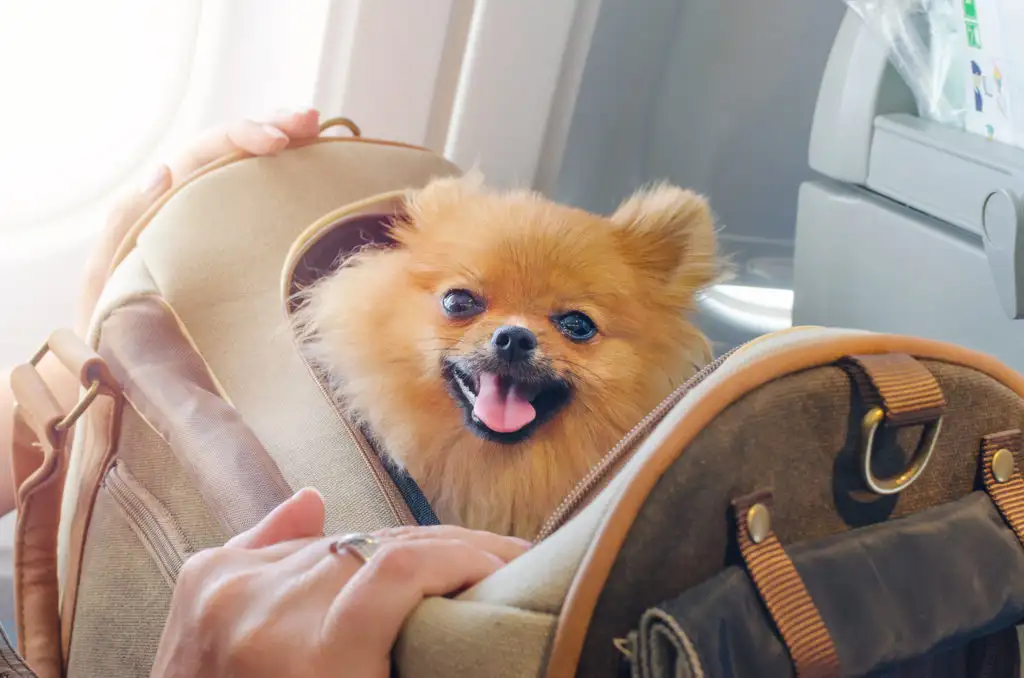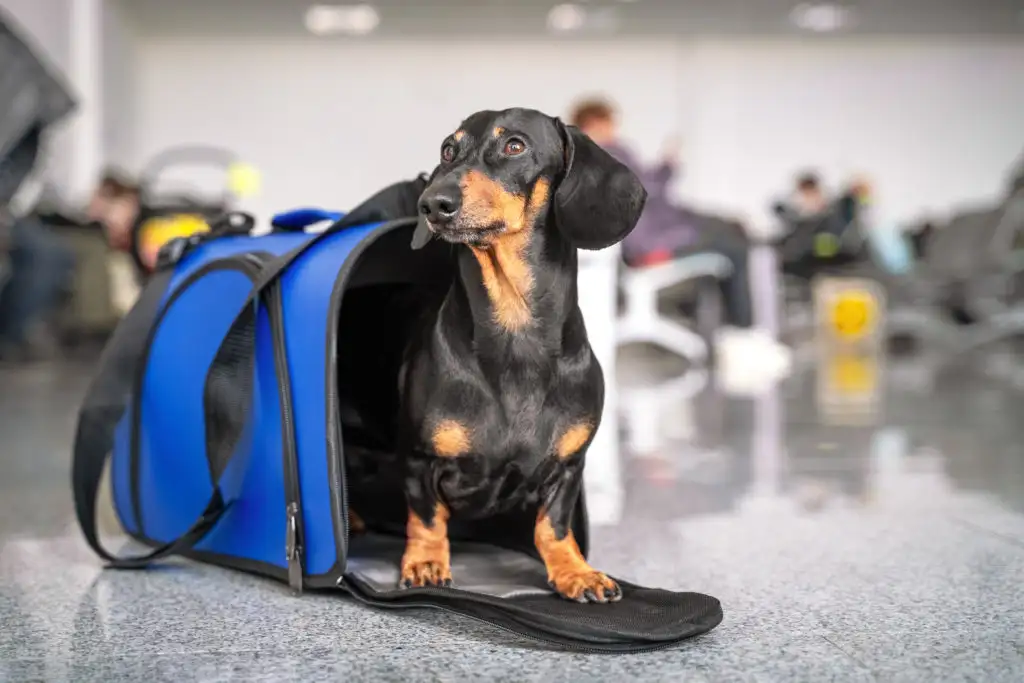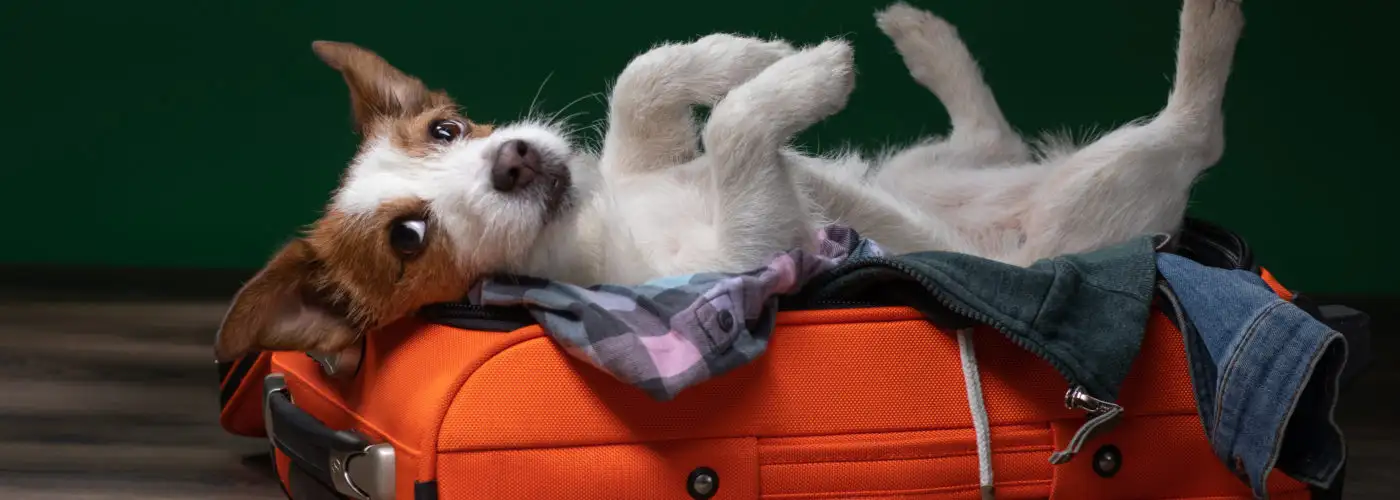Flying with a dog used to be fairly straightforward: Get a travel crate, don’t feed your dog too much, administer a sedative from your vet, treat the dog in its crate as checked luggage, and cross your fingers.
Today the process is more complicated, and for good reason; the old approach was not only challenging and a bit scary, but also frequently unsafe. Further, service and emotional support pets are now far more common on airplanes, introducing another layer of complexity to the rules surrounding pet air travel. Airline policies vary considerably by dog size, breed, temperament, and cabin vs. cargo rules, so there is a lot to know before you attempt to bring your dog on a plane with you.
General Considerations for Flying with a Dog

The choice to take your dog in the cabin with you versus traveling in the cargo hold will often be decided for you by the size of the animal and the airline’s policy; see the next section for airline policies in this regard. In general, carrying your pet into the cabin with you is safer than putting it into the cargo hold.
Some airlines restrict the total number of pets allowed on any given flight, and these spots are usually parceled out on a first-come, first-served basis—so you will want to book early.
Expect to pay a fee to fly with your dog. Current standard fees range from around $75 to $200 each way, and can go up to several hundred dollars for larger dogs that must be transported on cargo planes.
If at all possible, choose a direct flight. As tough as flying is on a dog, especially in the cargo hold, submitting them to even longer travel times plus multiple encounters with baggage handling can easily go sideways. My family flew cross-country with our dog several years ago, and had purchased direct flights, but due to aircraft problems on the way home had to switch to a connecting itinerary. During our connection in St. Louis, we watched helplessly through the airport windows as a baggage hander in St. Louis let our dog’s travel crate nearly free-fall onto the tarmac. When we picked her up at our home airport, the crate was shattered and the dog significantly traumatized.
Most airlines do not allow pets to travel in the exit row.
Consider the weather. In winter, fly during the day to ensure the warmest possible temperatures for your dog in the cargo hold. In summer, fly early or late to avoid the midday heat.
Get to the airport early enough to exercise your dog without creating a lot of time pressure.
Federal regulations require pets to be at least eight weeks old to fly.
If you have a young, senior, or fragile pet, consult with your vet as to whether they are up for the rigors of air travel.
Airline Policies for Flying with a Dog
Airline policies are all over the place; some carriers do not accept dogs for travel in the cargo hold, while others do not allow dogs in the cabin. Some have weight restrictions for travel in the cabin, others for the cabin and/or cargo hold, and they can vary tremendously; Air France currently allows the combined weight of dogs and their carriers to be up to 75 kilograms/165 pounds(!), while others top out at 32 kilograms/70 pounds.
Other restrictions include the length of the flight, destination, and even whether a codeshare is involved. Still others will only transport dogs as official cargo—that is, on an actual cargo plane. Expect to be charged an additional fee for transporting pets.
You can see comprehensive lists of airline policies at PetFriendlyTravel.com and BringFido.com. As useful as these lists are, however, you should always double-check your specific airline’s website for the most up-to-date information.
Breeds
The breed and/or physiognomy of your dog may determine whether they can fly with you; in particular, short-nosed breeds are not allowed by many airlines, and the American Veterinary Medical Foundation recommends that they not fly due to breathing difficulties and a higher rate of fatalities.
Contrary to some assumptions, it is not only smaller dogs that are of concern. The AVMA mentions the following dogs among those at risk: pugs, Boston terriers, boxers, some mastiffs, Pekingese, Lhasa Apsos, shih tzus, and bulldogs. Restricted dogs will often include mixed breeds, according to Tracey Thompson of PetFriendlyTravel.com.
“Most airlines include dogs that a mix of any of these ‘short-nosed’ breeds,” Thompson says. “The airlines are very strict about not allowing any of these dog breeds, so I would be surprised if there is any leeway. There is simply too much risk for the airlines to transport these breeds of dogs.”
Even with airlines that do allow short-nosed breeds, there can be certain limitations. Japan Airlines does not allow certain types of bulldogs due to their inability to regulate body temperature, while Lufthansa no longer allows short-nose breeds in the cargo hold.
Destination Considerations
If you are traveling outside the Continental U.S., you will want to make sure dogs are allowed to be brought along at all, and be prepared for surprises. For example, pets traveling to Hawaii are subject to quarantine because it’s the only rabies-free state. For foreign countries, you can usually find information on embassy websites.
Preparing Your Dog to Fly

A checkup from your vet is usually a good idea before flying with your dog. You might need a certificate of veterinary inspection to fly, in most cases signed within 10 days of travel.
On feeding, Nicole Ellis, a trainer with the pet-walking site Rover.com, advises the following: “Feed your pet lightly the day of travel and no sooner than four hours ahead of time. You don’t want to have any potty mishaps in the car, train, or airport! Dogs can go anywhere from 6 to 10 hours without food. Don’t change your pet’s food prior to a flight or give any treats he or she may not have had before, as it can cause an upset tummy on the flight.”
Exercise your dog as best you can on the day of travel, and then, as close to flight time as possible, find a place for your dog to take a walk, relieve itself, and get some fresh air. Options might include a walk around the hotel parking lot, finding a park on the way to the airport, or using dog-friendly facilities at many airports. PetFriendlyTravel.com also maintains a list of these by airport for both the U.S. and Canada.
Ellis notes that the once-common practice of sedating your dog is no longer advised: “The Humane Society does not recommend giving sedatives to pets to travel, but check with your vet if you have questions.” There can be a number of problems with sedation, including breathing issues, the dog’s inability to react if the crate is moved around, and a reduced ability to regulate body temperature. In fact, some airlines may ask you to sign a statement that your dog has not been sedated before flight.
Inside the Airport
Consider checking in on the later side to shorten the time your pet has no access to the outdoors.
Understand that busy airports are not naturally calming environments for many dogs, and do what you can to comfort your dog and help them avoid overstimulation.
Try to reserve a seat near the front of the plane if your dog is flying in the cargo hold, as this can get you off the plane a little more quickly.
At Your Destination
Upon arrival, the first thing you’ll want to do is find a place to get your dog outside. If you are traveling with a companion, consider having one person care for the dog immediately while the other collects luggage and arranges for a ride from the airport.
Speaking of arranging for a ride, make sure your car rental company, taxi, or rideshare driver allows dogs. Both Lyft and Uber leave the decision to allow non-service animals up to the individual driver, with Uber now letting passengers reserve a Pet-Friendly ride for an additional fee.
If you are going to be busy at your destination, consider setting up a dog walker to make sure your pet is getting enough exercise while you are out and about in places that don’t allow animals. Rover.com can work really well for this, as well as general caregiver sites like Care.com.
Ellis advises pet owners to check whether they can get their dog’s regular food at their destination: “Make sure your pet food is available at a pet store in your destination city, and if not, be sure to pack [some] or order some online and ship to your destination prior to arriving.”
Tools for Flying with a Dog
A comfortable and reliable carrier or crate is absolutely essential, and these have greatly improved since the old “plastic box” days; many come with wheels, backpack straps, and purse designs. Note that crates and carriers should be in good condition upon arrival at the airport. Airlines can reject your carrier if it has cracks or shows other signs of wear that might allow the dog to escape or be injured.
Make sure that your carrier is “airline approved.” Some of the best-reviewed carriers for the main cabin include the following:
- Petsfit Expandable Travel Dog Carrier
- Pet Magasin Soft-Sided Carrier for Cats, Puppies, and Small Dogs
- Snoozer Wheel Around 4-in-1 Pet Travel Carrier
And the following are well-reviewed larger crates/kennels for when your dog needs to go in the cargo hold. Again, make sure to double-check your airline’s requirements before traveling.
Some of the links featured in this story are affiliate links, and SmarterTravel may collect a commission (at no cost to you) if you shop through them.
Ed Hewitt is a seasoned globetrotter who brings you a glimpse into the latest travel news, views, and trends—and how they could affect your travel plans.
You Might Also Like:
• Airport Security Frequently Asked Questions• 8 Tips from a Flight Attendant’s Daughter to Save Money on Your Next Flight
• The Best and Worst US Airlines for Lost Luggage
• How to Cope with Lost Luggage on Vacation
• The Best Over-the-Counter Sleeping Pills for Long-Haul Flights
We hand-pick everything we recommend and select items through testing and reviews. Some products are sent to us free of charge with no incentive to offer a favorable review. We offer our unbiased opinions and do not accept compensation to review products. All items are in stock and prices are accurate at the time of publication. If you buy something through our links, we may earn a commission.
Related
Top Fares From
Today's Top Travel Deals
Brought to you by ShermansTravel
France: 8-Night Paris, Avignon & Nice...
Infinity Worldwide Vacations
 vacation
$2880+
vacation
$2880+
Poconos: 3 Nts in Garden of...
ResortsAndLodges.com
 hotel
$305+
hotel
$305+
7-Nt Canada & New England Cruise,...
Princess Cruises
 cruise
$839+
cruise
$839+




